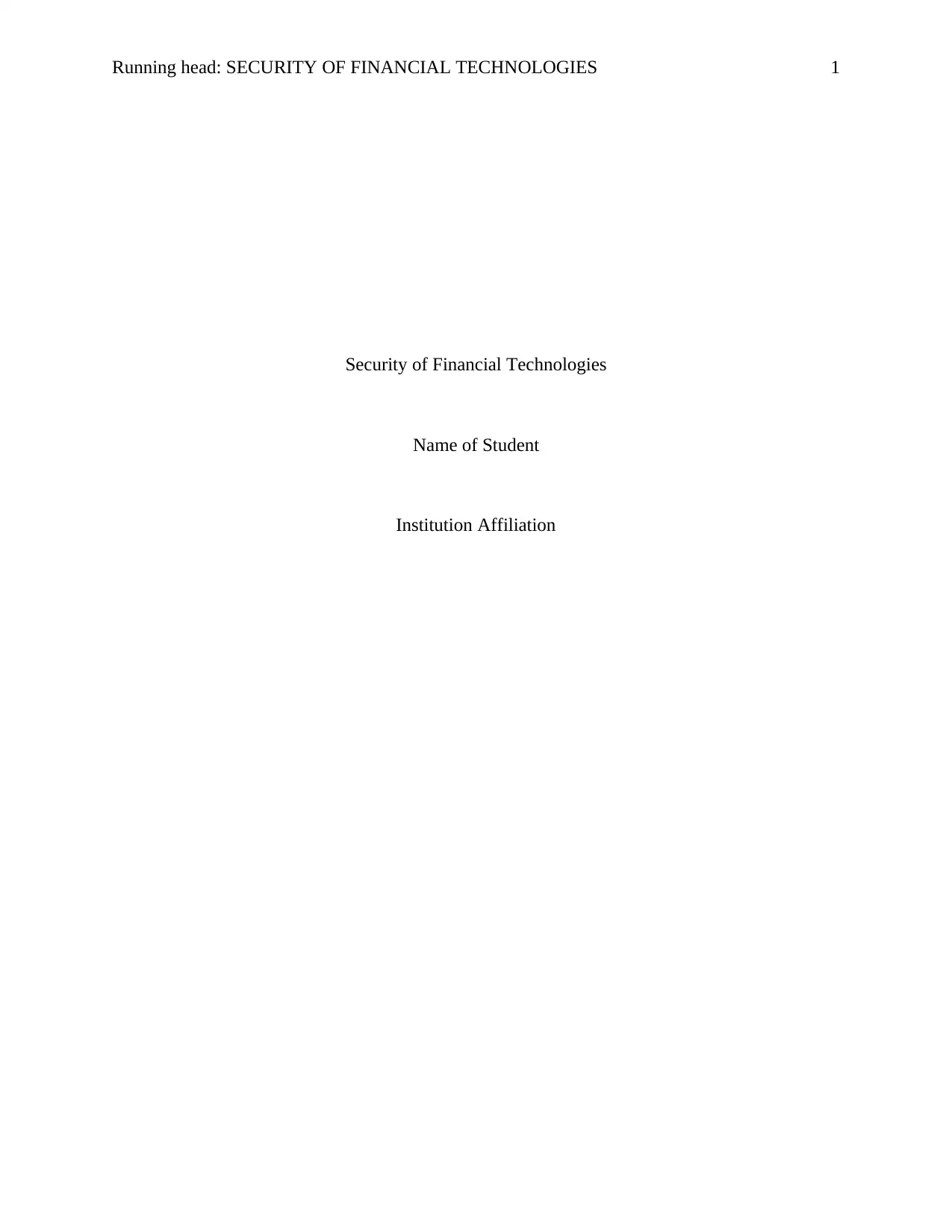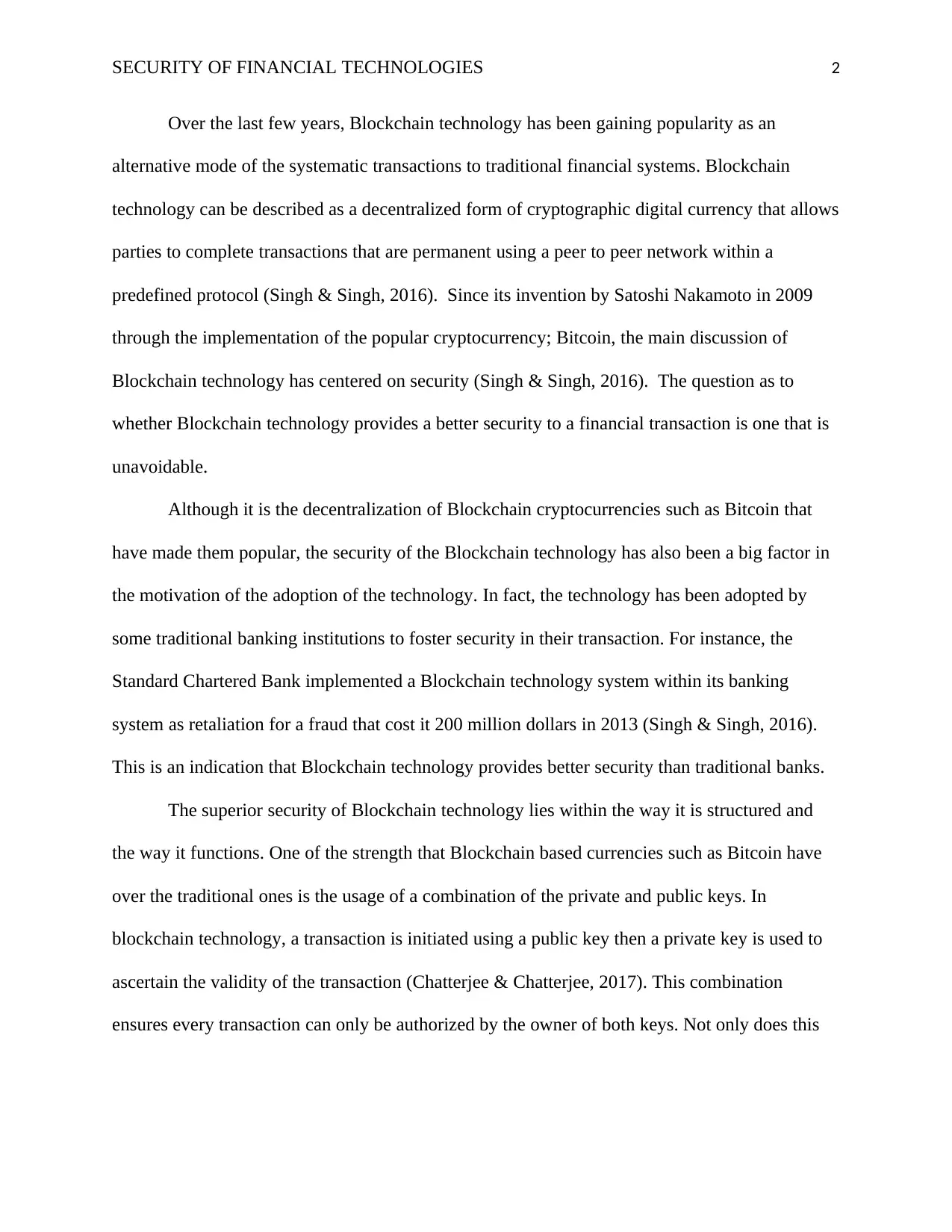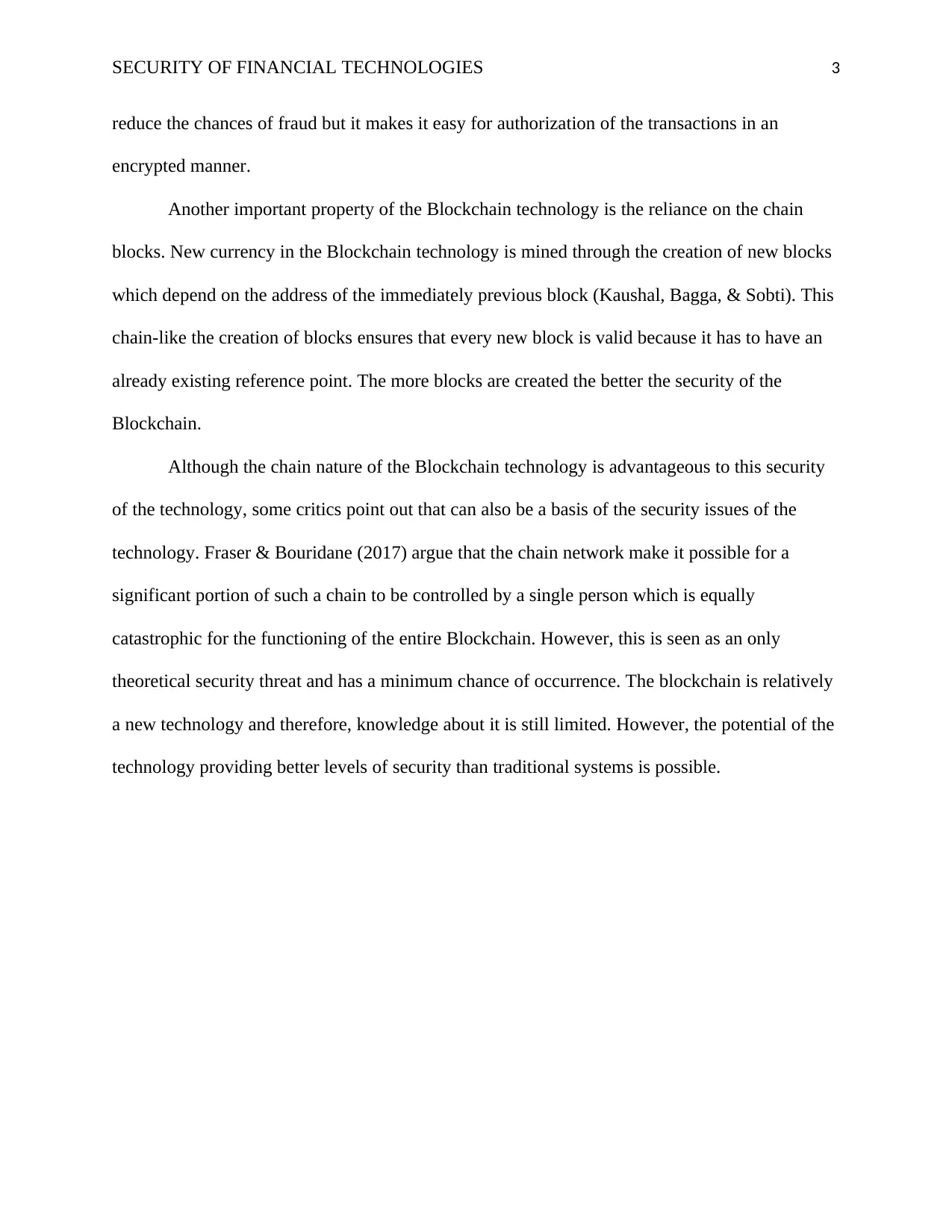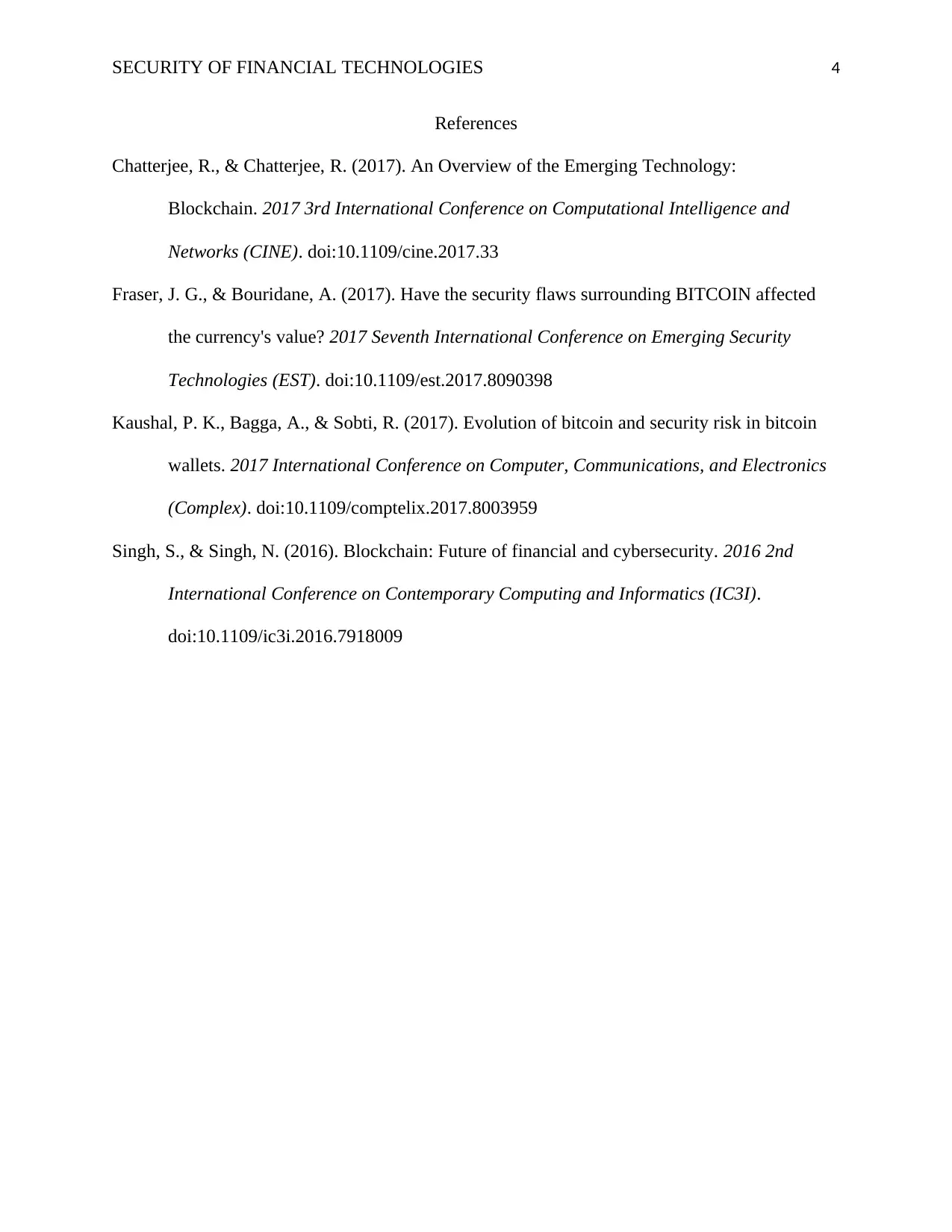Enhanced Security: Blockchain Technology in Financial Transactions
VerifiedAdded on 2023/06/15
|4
|751
|354
Essay
AI Summary
This essay examines the security of blockchain technology as an alternative to traditional financial systems. It discusses the decentralized nature of blockchain, particularly in cryptocurrencies like Bitcoin, and its adoption by institutions like Standard Chartered Bank following security breaches. The essay highlights the use of public and private keys for transaction authorization and the importance of chain blocks in maintaining security. While acknowledging potential theoretical threats, the analysis concludes that blockchain technology offers potentially better security levels than traditional systems, though further research is needed due to its relative novelty. Desklib provides access to similar solved assignments for students.

Running head: SECURITY OF FINANCIAL TECHNOLOGIES 1
Security of Financial Technologies
Name of Student
Institution Affiliation
Security of Financial Technologies
Name of Student
Institution Affiliation
Paraphrase This Document
Need a fresh take? Get an instant paraphrase of this document with our AI Paraphraser

SECURITY OF FINANCIAL TECHNOLOGIES 2
Over the last few years, Blockchain technology has been gaining popularity as an
alternative mode of the systematic transactions to traditional financial systems. Blockchain
technology can be described as a decentralized form of cryptographic digital currency that allows
parties to complete transactions that are permanent using a peer to peer network within a
predefined protocol (Singh & Singh, 2016). Since its invention by Satoshi Nakamoto in 2009
through the implementation of the popular cryptocurrency; Bitcoin, the main discussion of
Blockchain technology has centered on security (Singh & Singh, 2016). The question as to
whether Blockchain technology provides a better security to a financial transaction is one that is
unavoidable.
Although it is the decentralization of Blockchain cryptocurrencies such as Bitcoin that
have made them popular, the security of the Blockchain technology has also been a big factor in
the motivation of the adoption of the technology. In fact, the technology has been adopted by
some traditional banking institutions to foster security in their transaction. For instance, the
Standard Chartered Bank implemented a Blockchain technology system within its banking
system as retaliation for a fraud that cost it 200 million dollars in 2013 (Singh & Singh, 2016).
This is an indication that Blockchain technology provides better security than traditional banks.
The superior security of Blockchain technology lies within the way it is structured and
the way it functions. One of the strength that Blockchain based currencies such as Bitcoin have
over the traditional ones is the usage of a combination of the private and public keys. In
blockchain technology, a transaction is initiated using a public key then a private key is used to
ascertain the validity of the transaction (Chatterjee & Chatterjee, 2017). This combination
ensures every transaction can only be authorized by the owner of both keys. Not only does this
Over the last few years, Blockchain technology has been gaining popularity as an
alternative mode of the systematic transactions to traditional financial systems. Blockchain
technology can be described as a decentralized form of cryptographic digital currency that allows
parties to complete transactions that are permanent using a peer to peer network within a
predefined protocol (Singh & Singh, 2016). Since its invention by Satoshi Nakamoto in 2009
through the implementation of the popular cryptocurrency; Bitcoin, the main discussion of
Blockchain technology has centered on security (Singh & Singh, 2016). The question as to
whether Blockchain technology provides a better security to a financial transaction is one that is
unavoidable.
Although it is the decentralization of Blockchain cryptocurrencies such as Bitcoin that
have made them popular, the security of the Blockchain technology has also been a big factor in
the motivation of the adoption of the technology. In fact, the technology has been adopted by
some traditional banking institutions to foster security in their transaction. For instance, the
Standard Chartered Bank implemented a Blockchain technology system within its banking
system as retaliation for a fraud that cost it 200 million dollars in 2013 (Singh & Singh, 2016).
This is an indication that Blockchain technology provides better security than traditional banks.
The superior security of Blockchain technology lies within the way it is structured and
the way it functions. One of the strength that Blockchain based currencies such as Bitcoin have
over the traditional ones is the usage of a combination of the private and public keys. In
blockchain technology, a transaction is initiated using a public key then a private key is used to
ascertain the validity of the transaction (Chatterjee & Chatterjee, 2017). This combination
ensures every transaction can only be authorized by the owner of both keys. Not only does this

SECURITY OF FINANCIAL TECHNOLOGIES 3
reduce the chances of fraud but it makes it easy for authorization of the transactions in an
encrypted manner.
Another important property of the Blockchain technology is the reliance on the chain
blocks. New currency in the Blockchain technology is mined through the creation of new blocks
which depend on the address of the immediately previous block (Kaushal, Bagga, & Sobti). This
chain-like the creation of blocks ensures that every new block is valid because it has to have an
already existing reference point. The more blocks are created the better the security of the
Blockchain.
Although the chain nature of the Blockchain technology is advantageous to this security
of the technology, some critics point out that can also be a basis of the security issues of the
technology. Fraser & Bouridane (2017) argue that the chain network make it possible for a
significant portion of such a chain to be controlled by a single person which is equally
catastrophic for the functioning of the entire Blockchain. However, this is seen as an only
theoretical security threat and has a minimum chance of occurrence. The blockchain is relatively
a new technology and therefore, knowledge about it is still limited. However, the potential of the
technology providing better levels of security than traditional systems is possible.
reduce the chances of fraud but it makes it easy for authorization of the transactions in an
encrypted manner.
Another important property of the Blockchain technology is the reliance on the chain
blocks. New currency in the Blockchain technology is mined through the creation of new blocks
which depend on the address of the immediately previous block (Kaushal, Bagga, & Sobti). This
chain-like the creation of blocks ensures that every new block is valid because it has to have an
already existing reference point. The more blocks are created the better the security of the
Blockchain.
Although the chain nature of the Blockchain technology is advantageous to this security
of the technology, some critics point out that can also be a basis of the security issues of the
technology. Fraser & Bouridane (2017) argue that the chain network make it possible for a
significant portion of such a chain to be controlled by a single person which is equally
catastrophic for the functioning of the entire Blockchain. However, this is seen as an only
theoretical security threat and has a minimum chance of occurrence. The blockchain is relatively
a new technology and therefore, knowledge about it is still limited. However, the potential of the
technology providing better levels of security than traditional systems is possible.
⊘ This is a preview!⊘
Do you want full access?
Subscribe today to unlock all pages.

Trusted by 1+ million students worldwide

SECURITY OF FINANCIAL TECHNOLOGIES 4
References
Chatterjee, R., & Chatterjee, R. (2017). An Overview of the Emerging Technology:
Blockchain. 2017 3rd International Conference on Computational Intelligence and
Networks (CINE). doi:10.1109/cine.2017.33
Fraser, J. G., & Bouridane, A. (2017). Have the security flaws surrounding BITCOIN affected
the currency's value? 2017 Seventh International Conference on Emerging Security
Technologies (EST). doi:10.1109/est.2017.8090398
Kaushal, P. K., Bagga, A., & Sobti, R. (2017). Evolution of bitcoin and security risk in bitcoin
wallets. 2017 International Conference on Computer, Communications, and Electronics
(Complex). doi:10.1109/comptelix.2017.8003959
Singh, S., & Singh, N. (2016). Blockchain: Future of financial and cybersecurity. 2016 2nd
International Conference on Contemporary Computing and Informatics (IC3I).
doi:10.1109/ic3i.2016.7918009
References
Chatterjee, R., & Chatterjee, R. (2017). An Overview of the Emerging Technology:
Blockchain. 2017 3rd International Conference on Computational Intelligence and
Networks (CINE). doi:10.1109/cine.2017.33
Fraser, J. G., & Bouridane, A. (2017). Have the security flaws surrounding BITCOIN affected
the currency's value? 2017 Seventh International Conference on Emerging Security
Technologies (EST). doi:10.1109/est.2017.8090398
Kaushal, P. K., Bagga, A., & Sobti, R. (2017). Evolution of bitcoin and security risk in bitcoin
wallets. 2017 International Conference on Computer, Communications, and Electronics
(Complex). doi:10.1109/comptelix.2017.8003959
Singh, S., & Singh, N. (2016). Blockchain: Future of financial and cybersecurity. 2016 2nd
International Conference on Contemporary Computing and Informatics (IC3I).
doi:10.1109/ic3i.2016.7918009
1 out of 4
Related Documents
Your All-in-One AI-Powered Toolkit for Academic Success.
+13062052269
info@desklib.com
Available 24*7 on WhatsApp / Email
![[object Object]](/_next/static/media/star-bottom.7253800d.svg)
Unlock your academic potential
Copyright © 2020–2025 A2Z Services. All Rights Reserved. Developed and managed by ZUCOL.





